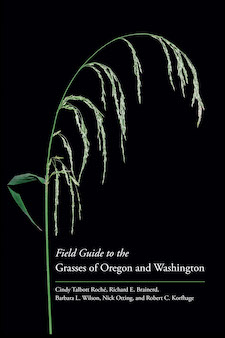Field Guide to the Grasses of Oregon and Washington
Last Updated on November 21, 2022 by

by Cindy Talbott Roché, Richard E. Brainerd, Barbara L. Wilson, Nick Otting, and Robert C. Korfhage.
ISBN 9780870719592
Oregon State University Press, Corvallis, Oregon, 2019
This is a review of the Field Guide to the Grasses of Oregon and Washington, a long-awaited book by a group of eminently-qualified and experienced botanists and ecologists. According to the authors, this work began in 2003 as a desire to complete a definitive reference work for the grasses of Oregon. Washington state was added later. I was asked to write a review of this field guide from the perspective of a field botanist/range conservationist who has dealt with, and often struggled with, grass identification over the course of several decades.
First, reading the 14-page introduction is crucial. Here you’ll find an explanation as to why grasses are important, a discussion of what constitutes a grass and a bit about grass identification in general. The bulk of the introduction consists of a section entitled “Grass Structure and Vocabulary” with the caveat “READ ME.” The authors aren’t kidding. Read and understand this section and you’ll know enough grass anatomy to be well on your way to becoming an agrostologist. This was enjoyable, even entertaining reading, enhanced by the inclusion of appropriate line illustrations. Completing the introduction are sections on grass biology and tips on how to use the book.
Following the introduction are the “Keys to the Genera of Grasses.” Starting at square one, dichotomous choices will take you first to “groups” and then to genera. Once you’ve determined (or guessed) a genus, the next section, “Genus Descriptions and Keys to Species” is where you need to be. Conveniently, this is organized alphabetically for all taxa. So if you key to the genus Hordeum, for example, thumb through the genus descriptions to Hordeum, and there you’ll find a key to determine species. So far, this is somewhat standard for most keys.
However, once you think you’ve identified your grass to species, then the next section, Species Accounts, is where this book really shines, not to slight the keys. Here you’ll (typically) find a page for each species, organized alphabetically. Generally two-thirds of each page is devoted to high quality, detailed photographs of each grass, from a general view of the plant itself all the way down to diagnostic features such as ligule size and shape, glume hairs and the like, including measurements where important. The rest of the page includes a map of the species’ occurrences from the Oregon Flora Project, a technical description, a brief habitat statement, and informative comments. Each species is also tagged as to its nativity (also indicated in the species keys), and, of course, the latest nomenclature is used.
As per the authors’ advice, one can either use the key, the species accounts, or both. For me, both are essential and my preference would be to use the key first, and then the species account to validate or refine. But if you know your genus, you could thumb through the species accounts to come up with an ID.
To test the key, I found a couple of dry, weathered specimens (all I could find mid-November) and worked them through. It seemed pretty easy but I can’t wait until next field season to really give it a workout.
Following the Species Accounts is a fairly standard glossary followed by a list of references and an index. The index is where you’ll find taxonomic synonyms.
What I really like about this book is that it’s technically correct yet friendly. For example, in the introduction is a brief discussion about spikelets being laterally compressed, cylindrical or dorsiventrally compressed. These can be intimidating words. However, the authors suggest you simply place the spikelet on a table and depending on how it orients itself, this will tell you how it’s compressed. In another case to determine if a spikelet is flat or not, it is suggested to just roll it between your fingers. These are simple “tricks” that only come with experience, and I’ve never encountered such helpful advice in any other key. It’s as if someone was looking over your shoulder helping you make sense of it all.
About the size of half a sheet of paper and an inch thick, the book is small enough to take with you to the field, and its glossy cover should provide some protection from the elements.
If you care about grass identification, either as an amateur or professional, you need this book. From my experience, no other grass key is as useful and user friendly. Along with GPS, GIS, digital cameras and Google Earth, I wish I had this book 40 years ago.
—Ron Halvorson, High Desert Chapter
